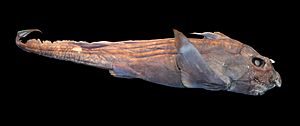Pointy-nosed blue chimaera facts for kids
Quick facts for kids Pointy-nosed blue chimaera |
|
|---|---|
 |
|
| Conservation status | |
| Scientific classification | |
| Genus: |
Hydrolagus
|
| Species: |
trolli
|
The pointy-nosed blue chimaera (Hydrolagus trolli) is a fascinating deep-sea fish. It's also known by other names like the pointy-nosed blue ratfish or abyssal ghostshark. This unique creature belongs to a family of fish called Chimaeridae.
Contents
Why is it Called That?
The second part of its scientific name, trolli, is a special tribute. It honors an American artist named Ray Troll. Ray Troll is known for including chimaeras in his amazing artwork.
Where it Lives
This deep-sea fish makes its home in the Pacific and Southern Oceans. It has been found near places like New Caledonia, New Zealand, and southern Australia.
The pointy-nosed blue chimaera is a true deep-water species. It lives on the slopes of continents and islands. You can find it at depths between 610 and 2,000 meters (about 2,000 to 6,500 feet). Most often, it lives even deeper, below 1,000 meters (about 3,300 feet).
In 2009, scientists saw fish that might be this species near California and Hawaii. Like many deep-sea animals, we don't fully know how far it spreads. But this chimaera was the first of its kind ever filmed alive. This helped scientists learn much more about it.
What it Looks Like
This fish has a special blue-gray color on its body. It has a dark line around its eyes. There are also dark shadows along the edges of its lateral line canals. These canals help the fish sense movement in the water.
The pointy-nosed blue chimaera has a very pointed snout. It can grow up to 120 centimeters (about 47 inches) long. It also has a venomous spine. This spine is located in front of its dorsal fin. The fish uses this spine to defend itself from danger.
Life Cycle and Reproduction
Female pointy-nosed blue chimaeras become adults when they are about 55 cm (22 inches) long. Males mature when they are a bit larger, around 60 to 65 cm (24 to 26 inches) long. This species is oviparous. This means the females lay eggs.
Interactions with Fisheries
The pointy-nosed blue chimaera does not have any commercial value. This means people don't usually fish for it on purpose. However, it can sometimes be caught by accident. This happens when fishing boats use deep-water nets called benthic trawls. This accidental catch is known as bycatch.
It might also be caught as bycatch in illegal fisheries for fish like the Patagonian toothfish. But most of the places where this chimaera lives are deeper than where these fishing boats usually operate. So, it's not caught very often.
Conservation Status
In June 2018, the Department of Conservation in New Zealand looked at the pointy-nosed blue chimaera. They decided to classify it as "Not Threatened." This means it is not currently in danger of disappearing. They also added the note "Secure Overseas." This suggests that the species is doing well in other parts of the world too.
See also
 In Spanish: Hydrolagus trolli para niños
In Spanish: Hydrolagus trolli para niños


